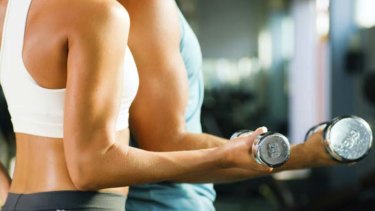If protein is the king of muscle mass food, nitrate might just be the king of muscle strength food.
A new Australian study has found eating nitrate-rich vegetables like spinach, rocket and lettuce significantly improves muscle strength and physical function as we age.
Power food … the nitrates in spinach, the vegetable which fuelled Popeye’s bulging muscles, boost energy.
From the age of 30, we begin to lose between three and five per cent of our muscle mass per decade and from the age of 50, we lose more than 15 per cent of our muscle strength per decade.
This natural decline, called sarcopenia, inhibits our physical function, making us weaker and more prone to falls and fractures.
While exercise helps to prevent muscle loss, nutrition helps too.
Researchers already know that regular consumption of nitrate-rich foods, which also include radish, beetroot, and celery, is good for heart health, reducing the risk of stroke by as much as 40 per cent. This is because nitrate breaks down into compounds that help regulate blood pressure.
These compounds – which act as vasodilators, opening blood vessels and allowing more blood and oxygen to be delivered to muscles – are the reason nitrate has become a popular sport’s supplement among athletes.
Drawing on this body of research, and the knowledge that there is a relationship between muscle function and cardiovascular health, lead author Dr Marc Sim from Edith Cowan University wondered whether a diet high in nitrate-rich foods might also help maintain muscle strength as we age.
Over the course of a year, Dr Sim and his team tracked the diets of 1420 Australian women aged over 70 and measured their muscle strength and physical function.
“Women with the highest intake of nitrate were consuming one cup of leafy green vegetables a day,” Dr Sim explains. “They had a two kilogram increase in grip strength, which is quite substantial.”
These women also completed the physical function test an average of 1.6 seconds faster than those who ate few or no leafy greens.
These findings are significant considering a grip strength decrease of one kilogram in 12 months is associated with a 33 per cent increased risk of mortality, and every second slower in physical function tests increases a person's mortality risk by eight per cent over three years.
While the team controlled for physical activity, total energy intake and BMI, more research is needed to confirm the findings and determine the mechanism.
Dr Sim hypothesises that, as well as the greater blood flow to the muscles, which enhances their function, nitrate may affect the way muscles handle calcium, which is important for muscle contraction.
“Another possibility is that [nitrate] changes the way the body processes energy – essentially the mitochondria [the energy powerhouses of the cells] may become more efficient,” he explains.
Dr Sim also distinguishes between muscle mass, which is supported by protein consumption, and muscle function.
“Mass and function are two separate things. Having more mass or less mass doesn’t necessarily predict how well they function,” he says. “Protein intake wasn’t a significant predictor of function or strength. Protein intake doesn’t necessarily influence function unless you are physically active as well.”
Besides, most Australians already eat enough protein (too much in many cases).
“What we are substantially lacking is sufficient vegetable intake,” Dr Sim says. “Only about seven per cent of Australians eat enough.”
As for the foods that will give you the most nitrate bang for your buck? Stay strong by upping your intake of rocket or arugula.
Source: Read Full Article
